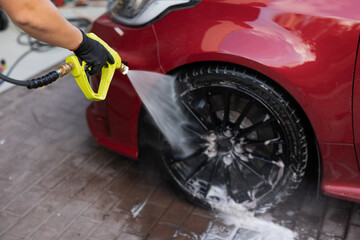A spotless vehicle turns heads even when parked. Kolby’s Auto Spa services go far beyond the basic car wash. It’s not just about aesthetics anymore. It’s a mix of preservation, protection, and pride.
Modern auto spas are evolving in subtle but game-changing ways. What once meant a quick rinse now includes therapeutic treatments for your car. Detailers now work like wellness practitioners, giving vehicles what they uniquely need. There’s thoughtfulness in every fiber wipe and polish layer.
One of the freshest ideas in auto spa care is sensory detailing. This approach includes customizing textures and aromas based on vehicle use and driver lifestyle. The result isn’t just shine—it’s comfort that subtly changes how the car feels. Soft-touch interiors become a signature rather than an afterthought.
New tools mimic the softness of human touch. These microfiber tech applications adapt to paint temperature and air conditions. They work gently under sunlight or shade, giving better results with less abrasion. It’s auto pampering tailored to environmental cues.
Drivers today expect luxury in even the smallest services. Some auto spas now integrate seasonal treatments. Warm waxes in colder climates protect like invisible armor. In warmer seasons, matte-protecting sprays reduce light reflection and paint fatigue.
Another recent upgrade is meditative waiting areas during auto treatments. While the car receives its glow-up, the owner relaxes in mood-lit spaces. This elevates the experience from errand to indulgence. The idea is simple: care for the driver while caring for the ride.
Innovation has also reached paint correction techniques. Adaptive compounds now correct surface flaws in micro-segments. This makes it possible to focus on imperfections without redoing entire panels. Paint retains more of its original integrity over time.
Wheel treatments used to be quick and overlooked. But now, wheels get their own suite of processes. Thermal decontamination, for example, ensures brake dust doesn’t etch into finish. Tire walls are treated with non-slip, non-shine finishes that feel like velvet.
Interior spa services now focus on touch memory. Detailers address fabric fatigue caused by repeated hand placement. Elbow wear on armrests or finger sheen on buttons are restored with custom blends. These fix the little signs of age you didn’t know existed.
Fragrance layering is another growing field in this industry. Auto spas design scent progressions that unfold subtly over days. Instead of a single strong odor, you get a time-released fragrance narrative. This changes the atmosphere inside the cabin entirely.
Micro-vacuuming is now standard in premium treatments. This method removes particulates as small as 0.3 microns from carpets and vents. You don’t see the difference, but you feel it—especially on long drives. Breathing is easier and materials last longer.
Even glass now gets specialized treatment. Instead of simple cleaning, detailers apply hydrophobic layers that adjust to weather changes. In rain, water beads instantly. In dry air, dust clings less. Your windows become adaptive rather than passive.
Some auto spas now map cleaning based on usage data. They use small onboard sensors or app integration to identify dirt hotspots. This data directs custom cleaning strategies per visit. Your commute literally helps design your detailing plan.
New wax blends focus on memory layering. These compounds remember the previous application and blend into it. So the more consistently you treat your car, the better it behaves with time. It’s spa science turning into vehicle loyalty.
Non-toxic solutions are now front and center. Premium auto spas emphasize ingredients safe for pets, kids, and the environment. These aren’t just branding claims—they’re part of industry shifts. Healthy detailing is the new gold standard.
Digital gloss readers now measure shine quantitatively. Your car’s finish can be scored for brilliance and corrected accordingly. That means less guesswork and more calibrated glow. Precision replaces opinion in the spa technician’s arsenal.
Sustainable water management also redefines this field. Some spas use less than two gallons per treatment through misting and recovery systems. Others treat their wastewater with on-site filters before reuse. It’s eco-luxury with performance in mind.
New service packages include wellness logs. Every visit documents the treatment given, product used, and vehicle reaction. Over time, this builds a health record for your car. Technicians can adjust future care just like a skincare routine.
Customization doesn’t stop with paint and polish. Auto spas now create custom soundproofing to enhance cabin quietness. They identify noise leaks and patch them discreetly. This gives a more silent and composed ride, even on rough roads.
LED inspections are also becoming essential. Instead of relying on room light, specialists use multi-spectrum LEDs to spot surface flaws. This helps them polish better with fewer passes. Less wear on the surface, more glow on the finish.
Ceramic coating upgrades are now staggered over multiple visits. Instead of one thick layer, thin films are applied weeks apart. This deepens durability and shine in layers. Like aging a good wine, the result improves with patience.
Touchless treatments are on the rise too. These use air, water vapor, and sound to clean without surface contact. It’s ideal for exotic finishes or custom wraps. Fragile surfaces finally get the attention they deserve without damage risk.
Color rejuvenation is another emerging trend. Without repainting, specialists use pigment activators to revive faded areas. This doesn’t add color—it amplifies what’s already there. It’s restorative, not decorative.
Steam detailing is now being used for control buttons and touchscreens. This method sanitizes without water residue or scratch risk. It reaches between panel cracks without disassembly. Cleanliness now comes with surgical precision.
Some services now tailor textures in the cabin. From gloss reduction on plastic to matte boosting on leather, everything is touch-sensitive. The driver feels the care before seeing it. Your fingers enjoy the spa just as much as your eyes.
Interior climate treatments are becoming standard. HVAC systems are flushed with bio-safe mist that neutralizes allergens. This keeps air circulation fresh for weeks. It’s wellness for the lungs delivered through hidden vents.
There’s a growing market for post-trip detox treatments. After long drives, vehicles accumulate invisible grime and bio-oils. Auto spas now offer detox packages that focus on deep renewal. Your car gets to rest and reset too.
Some premium packages now include invisible coatings. These go on parts you can’t see, like underbody panels and inside the hood. They resist rust, water, and thermal breakdown. It’s quiet protection that shows results in the long term.
New research looks into emotional response after spa treatments. Drivers report reduced stress and increased attention after detail visits. The cabin feels more inviting, so the drive feels less like a task. The experience reshapes how the car is perceived.
Even license plates get attention in high-tier packages. Specialists clean mounting brackets, buff plates, and align them symmetrically. Small as it sounds, it contributes to the car’s total symmetry. Spa services now consider every visual element.
Scheduling systems are smarter than ever. Some apps adapt based on traffic, weather, and driver usage to suggest ideal times. Others log vehicle exposure to pollen or road salt and suggest urgent services. Your car’s calendar becomes a digital caretaker.
Innovative drying techniques now use ionized air instead of heated fans. This method avoids heat stress on surfaces and dries faster. It’s quieter, more efficient, and gentler on sealants. The vehicle leaves with less water and less wear.
Color-enhancing foams are now used in exterior wash stages. These products brighten panels before waxing. They don’t stain or mask—they reveal. You see the original hue, alive and radiant.
A few spas are experimenting with light therapy for surfaces. LED light chambers enhance product bonding and reduce drying time. Cars rest in glow tunnels after treatment. The science behind it feels futuristic but is becoming real.
Mobile services are gaining upgrades as well. On-site spas now match in-house quality thanks to collapsible equipment. Cars can get the full experience without moving an inch. Luxury comes to your door without compromise.
Longevity testing is being added to reports. Clients receive data showing how long each product lasted under real-world conditions. This adds transparency and builds trust. The spa becomes a performance partner, not just a beauty shop.
Auto spas continue to evolve as the vehicle lifestyle transforms. These new services aren’t trends—they’re standards in progress. Drivers crave more than cleanliness. They want meaning behind the shine.
Every touch, every spray, every polish is part of a ritual. The auto spa is no longer just about the car. It’s about the human experience of being surrounded by something cared for. And that feeling, Besh, is worth every gleam.


